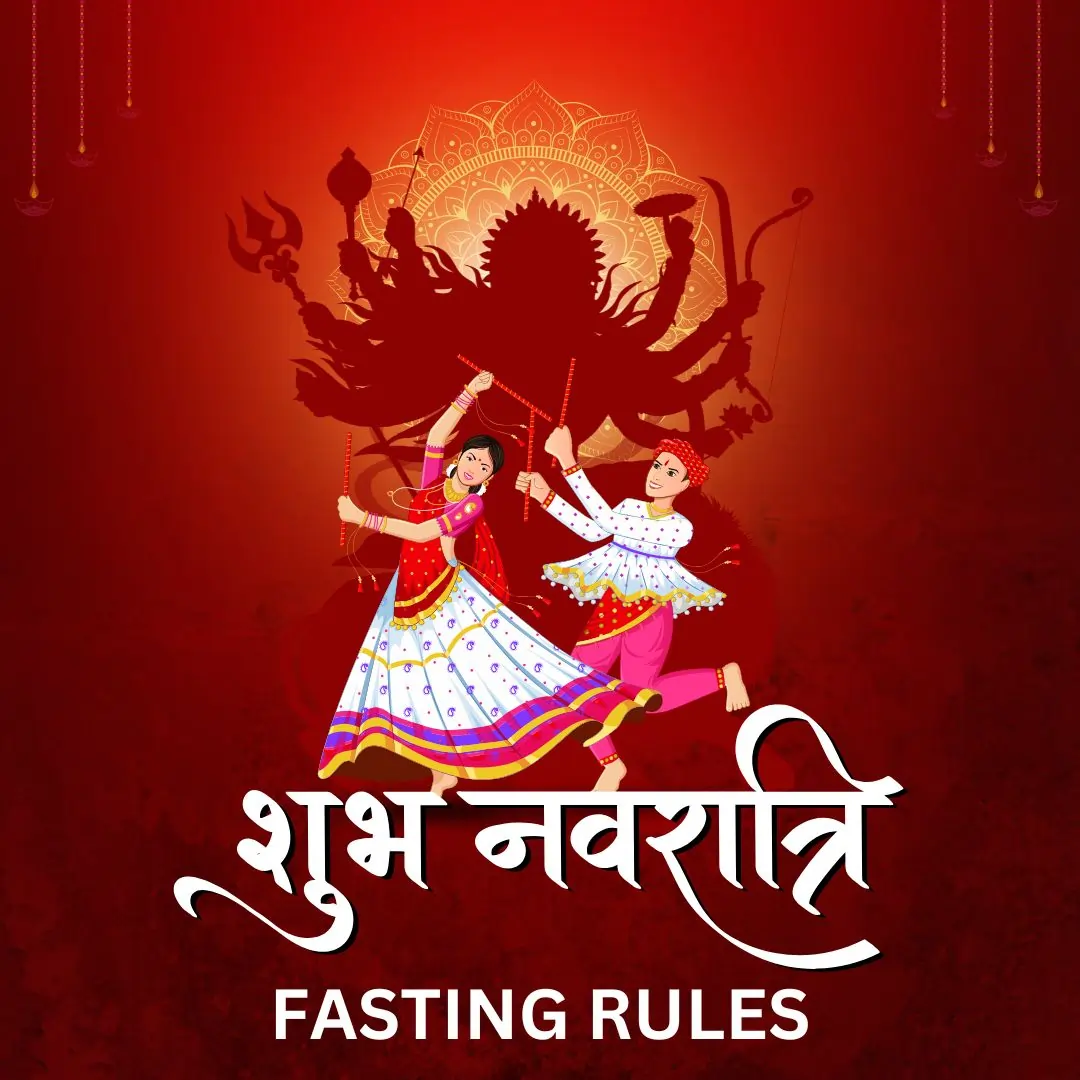Introduction
Navaratri 2025 fasting rules matter because they shape how devotees worship with discipline, clarity, and respect for tradition. Over nine sacred nights, families honor Goddess Durga’s nine forms through mindful food choices, structured puja, and community devotion. Moreover, the right method reduces confusion, protects health, and deepens spiritual focus. This guide sets out the essentials—what to eat, how to worship each day, and why these practices still transform lives.
Also read – Navaratri 2025 Dates & Significance: The Festival of Nine Nights
Navaratri 2025 Fasting Rules: A quick overview
Before diving into details, set your vow and choose a fasting style you can sustain. In practice, consistency beats intensity.
- Pick your pattern: water-only (nirjala), fruit-and-dairy (phalahar), or one/two vrat meals.
- Cook fresh: prepare food at home; avoid packaged items.
- Use rock salt: replace table salt with sendha namak.
- Stay sattvic: keep thoughts, words, and actions calm and truthful.
- Close the day properly: perform evening aarti, then eat.
Pro tip: If you have a medical condition, consult your doctor first. Devotion rules the heart; prudence protects the body.
Allowed & avoided foods during Navaratri 2025
What you can eat
To begin with, build meals from simple, energy-steady staples.
- Flours & grains substitutes: kuttu (buckwheat), singhara (water chestnut), rajgira (amaranth), samvat “rice”.
- Carbs & fiber: sabudana, sweet potato, potato, pumpkin.
- Proteins & fats: milk, curd, paneer, peanuts, makhana; ghee or cold-pressed oils.
- Fruits & add-ons: bananas, apples, papaya, coconut, dates, honey, lemon, cumin, black pepper.
- Seasoning: sendha namak only.
What to avoid
Conversely, skip anything that dulls clarity.
- No regular grains and pulses: wheat, rice, lentils, corn.
- No onion/garlic; no processed snacks.
- Strictly avoid alcohol and non-veg.
Sample vrat plates (practical ideas)
- Sabudana khichdi with roasted peanuts + yogurt.
- Kuttu cheela stuffed with paneer + mint-curd dip.
- Makhana kheer sweetened lightly with dates.
- Roasted sweet potato bowl with lemon, cumin, sendha namak.
Rituals that accompany fasting
Fasting works best when you pair it with worship. Therefore, align meals with puja times and keep rhythm through the day.
Kalash sthapana (Ghatasthapana)
At dawn on Day 1, set a clean altar, place the kalash with water, mango leaves, and coconut, and sow barley around it. Next, invite the Goddess with a simple sankalp (vow) and a ghee lamp.
Morning routine
Begin with bathing, cleaning the altar, lighting diyas, and reciting a short prayer or a chapter from Devi Mahatmya. Then offer flowers, fruit, and water.
Evening rhythm
After work, return to a calm space. Light the lamp again, sing aarti, and sit for five minutes of silent japa. Only afterward take your meal; in doing so, you keep the mind steady and grateful.
Kanya puja (Ashtami/Navami)
On Day 8 or 9, welcome young girls as embodiments of Shakti. Wash their feet respectfully, offer halwa-puri-chana, and give a small gift. As a result, you complete the vow with humility and joy.
Day-wise daily puja schedule for Navaratri 2025
Each day honors a distinct quality. Consequently, your offerings can reflect that virtue.
- Day 1 – Shailputri (strength): offer ghee; ask for grounding and good health.
- Day 2 – Brahmacharini (tapas): offer sugar; cultivate discipline and study.
- Day 3 – Chandraghanta (courage): offer milk or kheer; seek fearlessness.
- Day 4 – Kushmanda (vitality): offer pumpkin or malpua; welcome fresh energy.
- Day 5 – Skandamata (nurture): offer bananas; pray for family harmony.
- Day 6 – Katyayani (resolve): offer honey; address obstacles in relationships.
- Day 7 – Kalaratri (protection): offer jaggery; remove ignorance and anxiety.
- Day 8 – Mahagauri (purity): offer coconut; practice forgiveness.
- Day 9 – Siddhidatri (wisdom): offer sesame; dedicate actions to higher purpose.
Finally, on Vijayadashami, complete visarjan for the kalash or the invoked form, share prasad, and start something new—study, work, or service.
Health-first approach to fasting
Modern schedules can be demanding. However, you can still fast safely if you plan.
- Hydration strategy: water, lemon water, buttermilk, or coconut water every 2–3 hours.
- Protein & fiber: paneer, peanuts, makhana, and fruit help prevent sugar crashes.
- Portion control: eat to satiety, not to sleepiness; heavy plates cause afternoon slumps.
- Electrolytes: a pinch of sendha namak in warm water eases headaches.
- Breaks for elders or pregnant women: choose phalahar or one-meal fasts after medical advice.
Mindset, mantras, and meaning
Food rules shape the body; mantras shape the mind. Therefore, add a short practice you can actually keep.
- 3-minute breath focus before meals.
- 108-count japa of “Ya Devi Sarva Bhuteshu…” or “Om Dum Durgayei Namah”.
- Gratitude close-out each night: one line of thanks, one line of learning.
Common mistakes—and easy fixes
- All fried, no balance: swap one fried snack for roasted or steamed options.
- Too little water: set hourly reminders; attach sipping to tasks.
- Late heavy dinners: finish aarti earlier; eat 2–3 hours before sleep.
- Skipping aarti on busy days: run a 90-second ritual—lamp, three chants, silence.
- Over-planning menus: repeat 2–3 plates you enjoy; simplicity wins.
Navaratri 2025 fasting rules in special situations
Life differs; so should your plan.
- Students: schedule a fruit + paneer snack before study blocks; caffeine in moderation.
- Travelers: carry dates, roasted peanuts, and sendha namak sachets.
- Shift workers: move main meal to post-aarti, even if your aarti is at 6 a.m.
- Athletes: prioritize hydration, add paneer/peanut laddoos, and reduce volume on high-intensity days.
- Diabetics: coordinate with your physician; choose phalahar, focus on protein, and monitor glucose.
Do’s and don’ts (quick reference)
Do’s
- Plan meals, buy ingredients early, and batch-prep.
- Keep the altar tidy and the diya steady.
- Speak gently; if tempers rise, pause and breathe.
- Share food with someone in need.
Don’ts
- Don’t switch salts; keep only sendha namak.
- Don’t rely on ultra-processed “vrat snacks”.
- Don’t compare vows; choose what you can honour daily.
- Don’t miss evening aarti; shorten it instead.
FAQs
Can I drink coffee or tea?
Yes, in moderation. Nevertheless, prefer herbal teas or lemon water for calm energy.
What if I feel weak at work?
Add a small paneer portion or peanut mix at mid-morning; then increase fluids.
Is breaking the fast at Ashtami/Navami mandatory?
Traditionally, yes; still, consult your family priest or follow your regional custom.
Can children fast?
Light phalahar fasts are safer; prioritize nourishment and rest.
What if I accidentally eat a restricted item?
Resume calmly. Intention and sincerity matter more than perfection.
Conclusion
Observe Navaratri 2025 fasting rules with steadiness, and your days will feel lighter, clearer, and more focused. Because you pair sattvic food with structured prayer, the festival becomes a practical path: less distraction, more purpose. Start with a realistic vow, cook simple plates, keep aarti on time, and close each night with gratitude. In doing so, you honour tradition—and you strengthen body, mind, and heart.
Source
- Times of India Lifestyle – Navaratri Fasting Food List https://timesofindia.indiatimes.com/life-style (Good for allowed/restricted foods list.)
- Hindu Blog – Navratri Fasting Rules https://www.hindu-blog.com (Useful for regional fasting variations.)
- Ayush Ministry – Sattvic Fasting Guidelines https://www.ayush.gov.in (Health-first government reference on fasting & diet.)


1 Comment